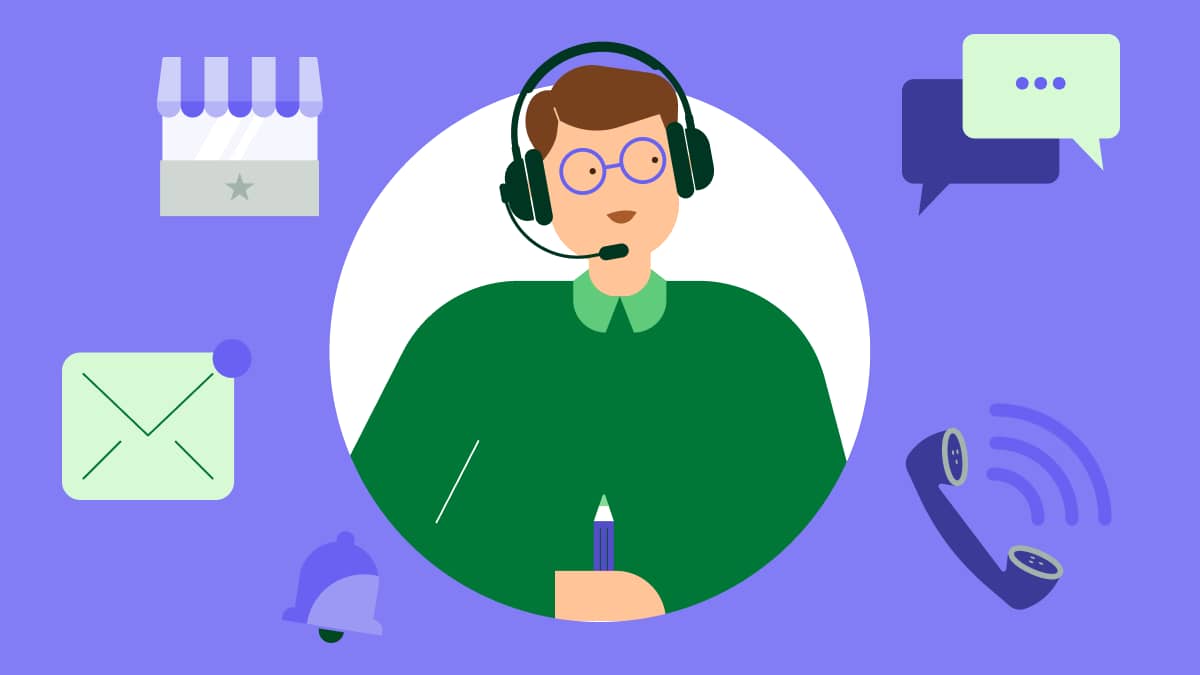Businesses often channel most of their resources into acquiring new customers. However, fostering customer loyalty is just as important.
Retaining existing customers saves time and money and can boost profits.
In this blog, we’ll explore what customer loyalty is, ways of building customer loyalty and how to measure your customer loyalty strategy.
What is customer loyalty?
Customer loyalty definition: Customer loyalty, or customer retention, refers to a customer’s commitment to a specific provider.
Customer loyalty programs aim to generate as much revenue as possible from existing customers by continually motivating them to make repeat purchases, deliberately enhancing lifetime value.
Improving the customer experience is a central part of customer loyalty. You can do this, for example, through outstanding product quality and good customer service.
It’s also important to develop specific marketing strategies to retain customers. Well-known methods include rewards programs, referral programs or perks like freebies.
The benefits of customer loyalty
Acquiring new customers is time-consuming and expensive. It requires companies to invest in advertising, content marketing and intensive sales calls. Customer loyalty offers a faster, cheaper alternative.
Here are some of the benefits of focusing on building strong customer relationships:
Sell faster
When you increase customer loyalty, you save the costs of advertising and onboarding new buyers. Existing customers already know what to expect from you regarding quality and customer service, so you don’t need to spend time and resources convincing them of your product’s value.
You can sell through a simple, solid sales page, emails or personal conversations.
Increase market share
Good customer loyalty creates a stable foundation for your company’s long-term success as current customers connect with you emotionally. This connection means they remain loyal even in tough times, easily resisting enticing offers from competitors.
Every repeat customer increases and stabilizes your market share, making your company resilient against crises and unexpected market developments.
Understand your customers better
The longer people use your products or services, the better you know your customer base’s desires and needs. As a result, you can support customers individually, develop personalized offers and help them achieve their goals.
All this makes it easier to sell new products and get loyal customers to renew contracts.
Increase purchase frequency
Data from McKinsey found that a successful customer loyalty program increases purchase frequency and means people will pay higher prices to stay with their preferred brand.

Brands with the best loyalty programs are also 117% more likely to be recommended by customers than those with the worst.
Turn customers into brand advocates
Successfully managing customer relationships can lead to higher customer satisfaction, which turns customers into brand advocates. They’ll refer your brand to their network via channels like word-of-mouth and social media content.
Referrals are a powerful form of marketing. For example, research from SAP Emarsys found that 39% of people are more likely to use an app if a friend recommends it.
Rewarding your advocates for a referral can also increase your brand loyalty. It gamifies their experience with your brand. The referrer recommends your product to get the reward and then stays to spend it. The more rewards they receive, the more money they spend with you.
Customer loyalty in B2B vs. B2C
Customer loyalty is often associated with B2C or direct customer interactions.
Customer retention is equally important in B2B. However, business decisions differ significantly from individual consumer choices.
Customer loyalty can be strong in companies where multiple stakeholders cooperate to evaluate contracts and make decisions. Because the process is so involved and deliberate, switching providers is rarely spontaneous, but rather a carefully considered transition.
On the other hand, if you lose a customer as a B2B, it can also be hard to win them back because the pool of potential buyers in B2B is often significantly smaller than in B2C.
Download Your Sales and Marketing Strategy Guide
The stages of customer loyalty
Customer loyalty has several stages. The stronger a customer’s relationship with the brand, the greater their loyalty and the more a business benefits from that relationship.
Marketing and business management professor Manfred Bruhn captured this relationship’s development in his model, the so-called “chain of effects of customer loyalty”, which consists of five phases:
1. Initial contact | A customer becomes aware of the company and makes their first purchase. |
2. Customer satisfaction | The customer compares their expectations with the product or service they receive. They only proceed to the next phase if they’re satisfied. |
3. Customer loyalty | The customer remembers their positive experiences from the second phase and associates positive feelings with the company. They’re open to renewing their contract or booking another offer. Switching to other providers seems unattractive to them. |
4. Customer retention | The customer makes another purchase. According to Bruhn, companies achieve customer retention when the customer not only repeats the purchase but also decides on another offer (cross-selling). The customer also starts recommending the company to others. |
5. Economic success | The company benefits from higher revenue and referrals from loyal customers. |
Nurturing your customers through the five stages ensures they become brand advocates who can help you grow your business organically.
The 5 types of customer loyalty
There are many reasons companies become loyal to a business. They culminate in five types of customer loyalty:
1. Situational customer loyalty
Situational customer loyalty occurs when customers have no choice but to turn to a specific company.
For example, local circumstances can play a role if a restaurant only has one option for its utilities, like electricity or water.
Alternatively, customers may use a brand because it offers discounts, freebies or free shipping. Options like these create a temporary sense of loyalty, but this convenience-based loyalty can fade once the offer ends.
2. Technical customer loyalty
Technical customer loyalty occurs when a customer buys into a closed system where they must obtain accessories, spare parts or support from the same brand.
Apple is a good example of this – it discourages users from getting their devices serviced through unauthorized shops or third-party partners.
3. Contractual customer loyalty
Contractual customer loyalty, or legal customer loyalty, arises when a customer enters into a contract that binds them for a certain period. The consistent income offers security for the business and reduces risks for buyers, as a contract can protect them from price hikes and help build a trusting relationship with the provider.
Telecommunications, streaming services and SaaS providers are common examples of contractual customer loyalty.
4. Economic customer loyalty
Economic customer loyalty occurs when it’s cheaper for a customer to stay with a brand than to leave.
In some industries, canceling a contract may cost the buyer and mean forfeiting prepaid services.
In other cases, businesses may stick with a specific tool they use across teams and have integrated with other programs in their tech stack. Changing these circumstances would require offboarding the current tool, purchasing the new software and retraining employees.
5. Emotional customer loyalty
Emotional customer loyalty occurs when customers feel attached to a brand. It’s the gold standard for customer loyalty as it’s the only type not influenced by external factors.
Achieving this emotional connection requires focusing on product quality, excellent customer service and personalized experiences.
For example, you could send personalized emails tailored to how customers use your product to ensure they get the most from it.
In the email below, digital collaboration platform Miro suggests more ways for a customer to use its product, giving them more reason to maintain their customer relationship:

Over time, Miro can become embedded in people’s daily work lives, making them loyal users who recommend the software to their network.
How to build customer loyalty
Over the years, companies have devised, tested and refined numerous measures for fostering customer loyalty. Many of these make customers want to return to a business because it will reward them.
Here are some effective ways to boost your customer loyalty:
1. Be customer-centric at every level
Initially a marketing and sales concept, customer centricity is now a corporate philosophy. It focuses on aligning all business decisions with customers’ needs and expectations, affecting everything from product development and marketing to customer service.
Customer loyalty means improving the usability and relevance of every touchpoint someone has with your brand. You want to not just meet their expectations, but exceed them.
For example, you might collect customer feedback via a customer survey to discover what features your users feel are missing.
Adding the features your customers want will show them that you value their opinions, which will help build customer loyalty and boost your bottom line.
2. Offer excellent customer service at every step
Offering excellent customer service to new or existing customers improves the customer experience. If reps handle complaints correctly, they could even turn detractors into advocates.
Here’s what you can do to enhance your customer service:
Implement a multichannel or omnichannel strategy so customers can reach you through their preferred channel, whether it’s your website, phone or social media. Ensure they find competent contacts across all platforms who can provide quick responses.
Make important information about your products and their use easy to find through a company blog, knowledge base or tutorials.
Enable customer self-service so customers can help themselves anytime without relying on a service team member.
Offer guarantees and a return policy. Doing so reassures your customers that if something goes wrong, they’re protected.
Cover shipping or return costs. Research in 2022 found that 68.2% of customers are more likely to purchase if they get free delivery. Offering free returns reassures your customers that if something isn’t right with a product, they won’t have to pay for it.
Establish a robust complaint management system. Unhappy customers should be able to voice their concerns, be taken seriously and be provided with suitable solutions. A strong customer complaint process can improve your Net Promoter Score (NPS) by seamlessly resolving customer problems.
Note: Good customer service goes beyond just attracting repeat business – it also affects your customers’ networks. According to data from Qualtrics, 26% of users who’ve had a negative experience will leave a negative review on a third-party site, and 21% will post about it on social media.
3. Personalize customer interactions
Personalization is a popular way to show customers you appreciate them. It’s a customer loyalty marketing technique that shows you value buyers, understand their needs and want to ensure they get the most from your product.
For example, writing assistant software Grammarly sends weekly writing updates to show users what they’ve accomplished in the past week.

You could adapt this approach for your audience by sharing similar achievements. For example, a B2B CRM could share information on deals closed, new deals or customer interactions from the previous week.
Implementing this technique almost gamifies using your tool, which can increase the likelihood that a customer will return to beat last week’s achievements.
Other ways to personalize your customer interactions include:
Engage deeply with your target audience to understand their desires and needs. The better you understand different customer groups or individual people, the better you can support them.
Segment leads and customers by criteria like age, location and interests using a customer relationship management system (CRM). Send them content suited to their needs and interests.
Assign customers a dedicated contact to make them feel seen and important. A clear contact connects them personally with your company, building customer loyalty to a person first, which is considerably easier than creating it with a company.
Personalized interactions improve brand loyalty by showing you understand your users and want to help them.
4. Reward customer engagement
Customer loyalty tools such as bonus programs, discounts and special offers can also enhance loyalty.
Rewarding customer engagement with discounts or freebies encourages people to return to reach the next milestone.
Examples include:
Awarding points for each purchase that customers can later redeem for rewards. Major carriers like Delta, United and American Airlines have robust frequent flyer programs. Several supermarket chains also use this customer loyalty technique.
Setting milestones for customers to achieve and rewarding them when they reach each one. Rewards could be prizes or virtual certificates. For example, Audible awards medals in customer accounts when a customer has listened to a certain number of hours or tried different genres.
Rewarding customer engagement with a point system or other loyalty programs gamifies the experience and makes your product more likely to become a regular part of their day.
5. Create a customer community
People are social beings and feel most comfortable when they’re part of a group. You can leverage this by building a community around your brand.
Many companies have community groups or forums. For example, in the Pipedrive Community, users can get resolutions to questions and interact with Pipedrive team members.
In an effective customer community, customers can interact, ask and answer questions, give feedback, share successes or showcase newly acquired products within the community, possibly via a forum or social media.
Your brand advocates can also develop followings and grow their own brand alongside their partnership with yours. This mutually beneficial relationship helps you tap into new markets and the power of referral marketing.
To start your customer community, you could create a Facebook or LinkedIn group, a Discord channel or a forum on your website.
How to measure customer loyalty
Customer loyalty analytics are relatively straightforward if your company has been around for a few years and has many customers. A history of sales and interactions gives you plenty of valuable data points to calculate metrics like conversion rate, customer retention rate and churn rate.
Using this data, you can actively track which types of customers buy which products and how often they purchase from you.
To get the insights you need, you must first collect the data. Here are some ways to get a sense of customer retention:
Survey customers. You can have them rate specific aspects of your service on a scale or ask open-ended questions.
Conduct customer interviews. Ask random customers about their experiences.
Use mystery shoppers. After randomized customers complete the purchase process, ask for feedback.
Request feedback on social media. Gain valuable insights into customer loyalty, identify areas for improvement and strengthen your relationship with your most valuable customers.
You can use this qualitative data to analyze why customers stop purchasing from you. These powerful insights help ensure your business stays appealing to your target audience.
The data you gather through methods above or through data reporting and analytics tools like a CRM can also help you calculate customer loyalty metrics such as:
Net Promoter Score (NPS) | NPS is based on asking users to rate how likely they are to recommend your product or service using a scale of 1–10. Scores let you identify your promoters and detractors.
Calculate your NPS by subtracting the percentage of detractors from promoters. |
Your CLV tells you the amount of money a customer will spend throughout their relationship with you in the short and long term. These numbers can help you decide if you’re spending your sales and marketing budgets in the right place. | |
Customer satisfaction score (CSAT) | How satisfied are customers with your product? CSAT data gives you insights into where you can improve your product and customer loyalty. |
Repeat purchase rate (RPR) | RPR tells you the percentage of customers who make repeat purchases, which can indicate customer sentiment and satisfaction. If your RPR is low, you may have a customer retention problem. |
Customer churn rate | Churn rate, or the rate of customer turnover, is an important metric, particularly for subscription-based businesses. The lower your churn rate, the more satisfied your customers are and the more important you are to their everyday lives. |
The more data you have, the more you can ensure your program is effective or look for ways to improve sales and marketing strategies.
Foster better customer loyalty with a CRM
Getting the most from customer loyalty requires a solid strategy, effective execution and regular evaluation. These factors ensure you hit your KPIs and get the highest ROI from your customer loyalty program.
A CRM system like Pipedrive helps you save time and use your resources efficiently and profitably.
Here are some of Pipedrive’s features that can help bolster your customer loyalty:
Keep everything you need to know about your customers in one place, from contact details to purchase records so you can tailor your interactions to build loyal customers. | |
Segment customers based on their purchase history, demographics or engagement levels so you can send them more relevant content. | |
Streamline your workflows by triggering specific actions such as follow-up emails after sales calls or reminders for contract renewals to keep customers engaged in the sales process. | |
Manage the customer journey from within Pipedrive with sales analytics, contact tracking and more. | |
Keep your customer interactions in one place so every sales team member can see customer interactions and provide a seamless sales and customer service experience. Use templates and an AI email writer to speed up communication. | |
Identify customer behavior patterns using predictive analytics to proactively support customers. For example, if you spot that a customer is likely to churn, you can initiate a re-engagement campaign. |
Pipedrive can help you identify patterns in your customer behavior so you can offer the right incentives at the right time to boost customer loyalty, wherever someone is in the customer journey.
Final thoughts
Your repeat customers make regular purchases, resist competitors’ offers and generate consistent revenue. They can even boost your marketing efforts.
Building a loyal customer base requires a solid retention strategy and careful monitoring of day-to-day customer interactions and behavior.
See how Pipedrive can help you streamline data collection and customer relationship management by starting your free trial today.












